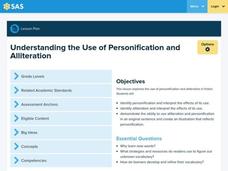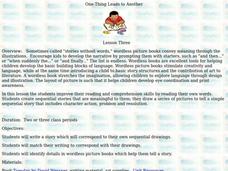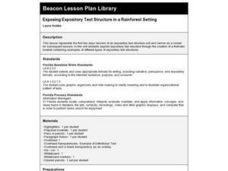Curated OER
Choose Your Words Wisely
Improve word choice! Writers use dictionaries and thesauruses to aid them in choosing exciting words to incorporate in their writing. They rewrite sentences and practice identifying words that can be replaced using a better word. Flip...
ReadWriteThink
Literature Circles: Getting Started
Make reading more enjoyable and interactive with literature circles! Here you'll find detailed lessons to begin the literature circle process. Ten lessons introduce each role learners take on. Literature circle roles include...
Curated OER
“THE LORAX” by Dr. Seuss
Few children's books convey the message of conservation as well as Dr. Seuss' The Lorax. Read the story aloud, emphasizing the interconnectedness of plants and animals in an ecosystem and discussing different ways people can help the...
Curated OER
Down the Knoll Without the Water
Students use a thesaurus to find synonyms for selected words in fairy tales.
Curated OER
Spelling: Homophone Review
Third graders practice using homophones. In this homophones instructional activity, 3rd graders review what makes a word a homophone and use clues to complete a worksheet that requires them to write in the correct homophone.
Curated OER
Noisy Nora, Studious Students: Story Elements
Alliterative adjective nicknames generate stories inspired by Rosemary Wells' book Noisy Nora (also a thematic complement to any class with children who make a ruckus to get attention). Class members explore basic story elements --...
Curated OER
Review of Personification and Alliteration
Students review personification and alliteration. In this literary devices lesson plan, students use personification and alliteration in a sentence. Students draw a picture reflecting personification.
Curated OER
Review of Personification and Alliteration
Students study personification and alliteration in various fiction texts. In this literary devices lesson, students use various texts to identify the literary devices of personification and alliteration. Students use examples of both...
Curated OER
Conflict Resolution in 9 Easy Steps
Students investigate student psychology by reading assigned text about nonviolence. In this conflict resolution lesson, students read nine specific steps they should take the next time they are in an argument with someone. Students...
Curated OER
Fairy Tales
Students explore fairy tales. In this fairy tales lesson plan, students analyze the main idea of a fairy tale and interpret it. Students then re-write the story from the point of view of another character or object in the story.
Curated OER
Crazy Critters Creative Writing
Students brainstorm animals with unusual characteristics such as a giraffe with a short neck or a zebra without stripes. They write paragraphs about their animals and work in peer editing groups to refine their stories.
Curated OER
Basic Letter Response to a Writing Prompt
Students respond to a writing prompt using appropriate letter format. For this letter writing lesson, students discuss the format for letter writing and use the worksheet format to write the heading, inside address, and salutation....
Curated OER
One Thing Leads to Another
Students analyze the storytelling methods in wordless books. In this visual storytelling lesson, students write a story that correspond to a specific wordless picture book. Students create their own wordless picture book after...
Curated OER
Exposing Expository Text Structure in a Rainforest Setting
Students create a thematic booklet containing examples of different types of expository text structures. They explore a variety of expository text structures.















